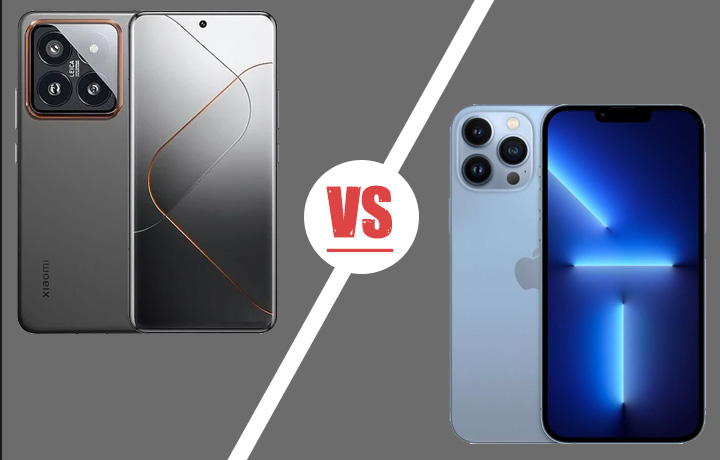Xiaomi 14 Pro vs iPhone 15 Pro Max: Full Comparison “Pros And Cons”
In the world of flagship smartphones, two titans have emerged, each armed with cutting-edge technology and premium features. The Xiaomi 14 Pro and the iPhone 15 Pro Max stand at the forefront, both vying for the attention of discerning consumers. With the unveiling of these devices, the tech world witnessed a clash of innovation, particularly with the introduction of titanium frames – a feat once considered exclusive to high-end devices.
As we delve into this preliminary comparison, we aim to dissect the strengths and weaknesses of each contender. From design intricacies to camera prowess and software optimization, we’ll navigate the intricacies that make these devices distinct.
Design and Size:
The Xiaomi 14 Pro and iPhone 15 Pro Max share many design similarities, including their dimensions, weight, thickness, and camera bump positions. However, there are some key differences worth noting.
The Xiaomi 14 Pro boasts a curved display, a common feature in Chinese flagship phones, while the iPhone 15 Pro Max features a flat display. Both phones are protected by tough glass materials, with the iPhone sporting Apple’s Ceramic Shield and the Xiaomi using Longjing Glass.
One noticeable design difference is the front-facing camera setup. The iPhone 15 Pro Max employs a pill-shaped cutout for its front cameras, while the Xiaomi 14 Pro uses a hole-punch design. Another distinction is in the retail packaging, as the Xiaomi is expected to include a fast charger in the box, while the iPhone comes with a USB-C cable only.
Both phones come in a range of colors, with the Xiaomi 14 Pro offering Black, Silver, Titanium, and Green options, while the iPhone 15 Pro Max is available in Black Titanium, White Titanium, Blue Titanium, and Natural Titanium.
Display Differences:
The display specifications of these two phones are quite similar. Both feature 6.7-inch OLED panels with variable refresh rates and high brightness levels. However, the Xiaomi 14 Pro takes a slight lead with its 1440 x 3200 pixel resolution, resulting in a pixel density of 522 ppi, compared to the iPhone’s 1290 x 2796 pixel resolution and 460 ppi.
One area where the Xiaomi 14 Pro potentially outshines the iPhone is in peak brightness. Xiaomi claims a peak brightness of 3000 nits, while the iPhone is rated at 2000 nits. Further testing will be necessary to confirm these claims.
Biometric authentication methods differ, with the Xiaomi 14 Pro featuring an under-display fingerprint reader and the iPhone relying on Face ID. While Face ID is known for its reliability, the effectiveness of Xiaomi’s under-display fingerprint scanner remains to be tested.
Performance and Software:
In terms of performance, the Xiaomi 14 Pro is powered by the latest Qualcomm Snapdragon 8 Gen 3 chip, a promising contender. Benchmarks and real-world testing will be necessary to determine how it stacks up against the iPhone 15 Pro Max’s Apple A17 Pro. While the Xiaomi offers more RAM, iPhones are known for their exceptional optimization, allowing them to perform well with less RAM.
The Xiaomi 14 Pro runs Android 14 with HyperOS, while the iPhone 15 Pro Max comes with iOS 17. The longevity of major OS updates for the Xiaomi remains uncertain, as it typically lags behind Apple in this department.
Camera:
The camera setups on these devices showcase some intriguing differences. While Apple introduced a novel tetraprism lens in the iPhone 15 Pro Max for zoom capabilities, Xiaomi has a history of using periscope zoom lenses and continues this trend with the Xiaomi 14 Pro. What’s unique about the Xiaomi is the variable aperture on its main camera, a feature reminiscent of the Huawei Mate 50 Pro.
The Xiaomi 14 Pro’s 50MP main camera offers an aperture that can vary between f/1.42 and f/4.0, giving users more control over their photography. Additionally, the Xiaomi 14 Pro boasts a 50MP ultrawide camera and a 50MP telephoto camera with 3.2x optical zoom. In contrast, the iPhone 15 Pro Max utilizes two 12MP cameras for its ultrawide and telephoto functionalities. Keep in mind that higher pixel counts don’t guarantee better photo quality, so a hands-on comparison is needed to evaluate camera performance.
Battery Life and Charging:
The Xiaomi 14 Pro houses a 4880mAh battery, significantly larger than the iPhone 15 Pro Max’s 4441mAh battery. The Xiaomi also offers impressive charging capabilities with 120W fast wired charging and 50W fast wireless charging. Xiaomi claims a rapid 0–100% charge in about 18 minutes with wired charging and 40 minutes with wireless charging. While the global version of the Xiaomi 14 Pro may have slightly reduced charging speeds, it still outpaces the iPhone’s charging capabilities.
In contrast, the iPhone 15 Pro Max retains similar charging speeds to its predecessor, despite gaining a USB-C charging port. It offers 50% charge in 30 minutes with wired charging and a modest 15W wireless charging speed.
Specs Comparison:
The Xiaomi 14 Pro and iPhone 15 Pro Max present a compelling showdown in the premium smartphone segment. The Xiaomi 14 Pro boasts a brilliant and crisp display, a versatile camera system with variable aperture, a powerful Snapdragon 8 Gen 3 chipset, and impressive charging capabilities, including the option for a titanium frame.
On the other hand, the iPhone 15 Pro Max, while seemingly lagging behind in certain specifications, has consistently proven that spec sheets don’t tell the whole story. In-depth testing of the Xiaomi 14 Pro is necessary before drawing a final verdict. Pro, Cons, and more details on the NEXT PAGE…
- Related content:
- Samsung Unveils Galaxy Tab S9 Tablet Series
- Samsung Galaxy Watch 6 vs. Galaxy Watch 6 Classic
- Garmin Forerunner 265 vs. Forerunner 965










